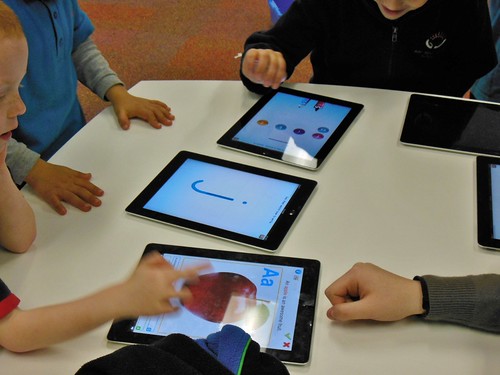On the 30th of August, I participated in a panel discussion at the 5th Foreign Language Forum in Athens, Greece. The main theme was “Present, Motivate, Engage”; Lilika Couri talked about Presentation, Luke Prodromou about Motivation and myself about Engagement. In this blog post, I will go through what was in my presentation both for those who attended and did not have the time to make notes and for those who couldn’t make it but are interested in the topic.
What is Student Engagement?
“To teach is to engage students in learning” (Christensen, 1991).
![]() I think the above quote captures the essence of Student Engagement in learning and suggests that the role of the teacher is not to provide knowledge but to design and facilitate learning opportunities.
I think the above quote captures the essence of Student Engagement in learning and suggests that the role of the teacher is not to provide knowledge but to design and facilitate learning opportunities.
However, while there is general agreement that Student Engagement is vital to learning, the definition of the term itself is fairly ambiguous (Parsons & Taylor, 2011). For some, it means compliance and academic achievement while for others, active involvement in and enthusiasm about the learning experience. Below are two definitions that clearly suggest that various factors are at play when students fully engage in learning.
‘Student Engagement has been used to depict students’ willingness to participate in routine school activities such as attending classes, submitting required work, and following teachers’ directions in class’ (Nystrand & Gamoran, 1991).
‘Students who are engaged show sustained behavioural involvement in learning activities accompanied by a positive emotional tone. They select tasks at the border of their competences, initiate action when given the opportunity and exert intense effort and concentration in the implementation of learning tasks’ (Skinner & Belmont, 1993).
Which one do you agree with? Do you think they complement each other (as the audience of the 5th FL Forum suggested) or that they are quite distinct?
How can we increase student engagement in the language classroom?
Below are some steps that I have found effective. The list is by no means exhaustive and you are more than welcome to contribute your own ideas and experiences:
Use technology (but not for the sake of it)
 Students today are quickly bored with texts and lectures because of their immersion in technology and the exciting multimedia tools they use every day to communicate, learn and entertain themselves. The truth is that technology offers amazing opportunities to engage students in learning; we can create content and share it with the world, we can find information at the click of a button, and we can interact with people beyond classroom walls. So, technology is engaging but to contribute to learning we need to make pedagogically sound use of it. Technology is not a magic bullet so don’t use it just because it’s available or cool. If you want to read more about this take a look here.
Students today are quickly bored with texts and lectures because of their immersion in technology and the exciting multimedia tools they use every day to communicate, learn and entertain themselves. The truth is that technology offers amazing opportunities to engage students in learning; we can create content and share it with the world, we can find information at the click of a button, and we can interact with people beyond classroom walls. So, technology is engaging but to contribute to learning we need to make pedagogically sound use of it. Technology is not a magic bullet so don’t use it just because it’s available or cool. If you want to read more about this take a look here.
Encourage interaction and collaboration
It’s been said that collaboration is the new competition and I totally agree. Apart from being engaging, teamwork is a 21st-century skill that we should help students to develop. So get students to collaborate with other classes, preferably from another country. In this way, they will have a real purpose to communicate in English. Blogging is a great way to extend communication beyond the boundaries of the classroom because it’s highly interactive; students can write blogs for an extended audience but they also read and comment on other students’ blogs.
Just bear in mind that they will need language and teamwork skills to interact effectively; teach them how to negotiate and debate how to disagree politely. They should welcome diversity and appreciate other people’s opinions no matter how different they are from theirs.
Create an emotionally safe environment
To be engaged in learning, students need to take risks but they are not going to iif they feel emotionally unsafe. To help students,
- create a class environment that tolerates mistakes
- teach students to support each other
- give the thumbs down to people who laugh at others
- wait for slower students and don’t just call on the first ones that raise their hand
- Help them to build their self-efficacy by beginning every lesson with a task that all students can do without your help; then gradually follow up with more challenging ones until you give all students the opportunity to be involved.
Scaffold challenging tasks
 Suppose you ask your students to find information about a person (historical, celebrity etc) and then write an imaginary interview with him/her. Although this is a very creative task, your students might be challenged by a number of things that can slow production. To engage them, create intermediate steps by:
Suppose you ask your students to find information about a person (historical, celebrity etc) and then write an imaginary interview with him/her. Although this is a very creative task, your students might be challenged by a number of things that can slow production. To engage them, create intermediate steps by:
- asking them to brainstorm with a peer who they are going to interview
- teaching them how to search online for relevant vocabulary
- devising quality questions
- role-playing the interview with a peer
- how to cite their sources and attribute the information they use to the writer.
 Photo Credit: Olivier Jeannin via Compfight
Photo Credit: Olivier Jeannin via Compfight
Encourage Reflection
Reflection is a key ingredient to learning and engagement. According to Dewey (1933), reflective learners control their learning “by assessing what they know, what they need to know, and how they bridge that gap”.
If we want students to get in the habit of reflection, we should regularly invite them to analyse and make judgments about what they have learned.
Start using the “3-2-1” reflection activity at the end of every lesson by asking students to record three things they learned, two things they found interesting and a question about what was taught (Hurst, 2013). If this sounds time-consuming, you can ask them to record their reflections on a learning platform such as a class blog or Edmodo which will allow you and your students to interact with each other beyond lessons.
Support exploration and develop digital literacy
![]() Photo Credit: hjl via Compfight
Photo Credit: hjl via Compfight
Learning is all about exploration but your students will need to have research skills to engage in it. The Internet can provide access to outstanding sources of knowledge at the click of a button. The problem nowadays, however, is that while young people are particularly confident users of technology, they often lack the skills to make effective and responsible use of it. So, teach them how to:
- find information by using keywords effectively
- evaluate and challenge online content; not everything they read online is accurate or trustworthy 😉
- synthesise information into their own original argument and avoid plagiarism.
Incorporate movement into your lessons
Movement is a vital part of our daily lives and can revitalize both young learners and adults. To influence your students mood make sure you use one (or more) of the following in every lesson:
- ask students to write on the board
- ask them to take a stretch break, that is stand and stretch between parts of the lesson
- use mingling activities. You might think that students will get overly excited but this is because they are not used to the procedures. If mingling is a regular part of your lesson students then students will perceive it as such.
- ask students to move to a different part of their room to find a partner and compare notes or answers. Don’t just ask them to work with the person sitting next to them.
- If students have to answer various task questions, divide the questions in 4 groups and ask students to walk to a different corner to discuss them.
Foster creativity
When we ask students to create something, we help them to develop ownership over their learning and feel that their ideas and originality matter. Foster creativity by
- using art in the classroom
- asking them to create videos or podcasts. There are some great tools available.
- integrating digital storytelling tools to create stories with them.
- asking them to share what they create with others (preferably online) and get feedback. This is when creativity becomes meaningful.
Use humour
 A good laugh eases tension and helps students to feel more comfortable and open to learning. Even if you are not a naturally funny person, you can still lighten things up with the following:
A good laugh eases tension and helps students to feel more comfortable and open to learning. Even if you are not a naturally funny person, you can still lighten things up with the following:
- Spice up tests and assignments with humorous items
- Have a Joke Friday – ask students to bring in jokes to share with classmates
- Keep a cartoon file – Have an area where students can display a cartoon every day on a rota basis – If you have a class blog ask them to post it there
- Ask students to try and build humour into writing assignments. This is a valuable writing skill that will also add fun to your classes (Elias, 2014).
Incorporate alternative ways of assessment
According to Armstrong (2006), ‘standardised testing often leads teachers to teach to the test instead of students’ needs, interests, and abilities’. This may be true. While curriculum teaching requires teachers to evaluate specific content knowledge through testing, tests should not be the only means students are evaluated. Incorporate alternative ways of assessment such as:
- student (electronic) portfolios that depict their progress over time
- student presentations, blog posts or project work. If they work in groups, don’t forget to evaluate their teamwork skills.
Exam classes may be a bit different but you can always use alternative ways from time to time.
Provide a good model
‘Energised teaching fosters energised learning, monotonous teaching sabotages attention’ (Intrator, 2004). So, be an engaged teacher. Be authentic, share personal stories, convey your passion, express emotion and don’t be afraid to make mistakes. You don’t need to dominate the class to show involvement. As Roppo (2014) suggests “great leaders guide, direct and inspire with an easy strength, but they never dominate.”
Can you add some more ideas to the list? Have you found other ways to engage your students in learning?
References
Armstrong, T. (2006). The Best Schools: How human development research should inform educational practice. Alexandria, VA: Association for Supervision and Curriculum Development (ASCD).
Christensen, C. (1991). Education for judgment: The artistry of discussion leadership. Boston, Mass.: Harvard Business School Press.
Dewey, J. (1933). How we think: A restatement of the relation of reflective thinking to the educative process. Boston: Houghton Mifflin.
Elias, M. (2014). Using Humor in the Classroom.
Hurst, S. (2013). Seven Ways to Increase Student Engagement in the Classroom.
Intrator, S. (2004). The engaged Classroom. Educational Leadership, 1 (62), 20-25
Nystrand, M., & Gamoran, A. (1991). Instructional discourse, student engagement, and literature achievement. Research in the Teaching of English, 25(3), 261-290.
Skinner, E. A, & Belmont, M. J. (1993). Motivation in the classroom: Reciprocal effects of teacher behavior and student engagement across the school year. Journal of Educational Psychology, 85(4), 571-581.
Parsons, J. & Taylor, L. (2011). Student Engagement: What do we know and what should we do? University of Alberta: University Partners.
Comments are closed